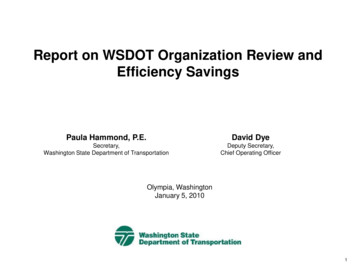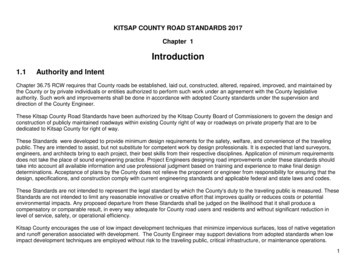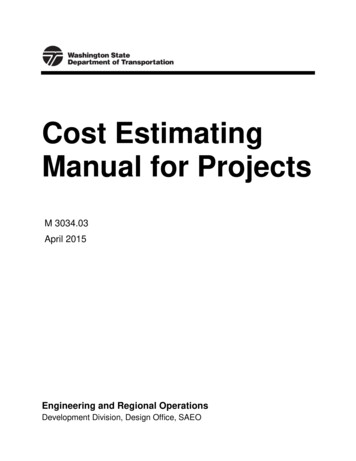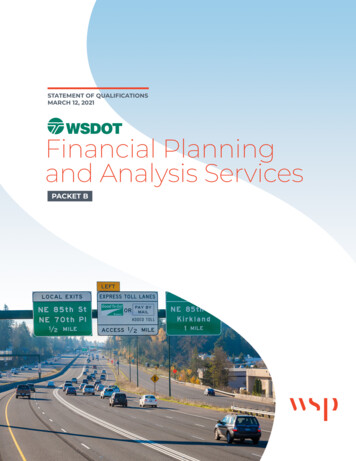
Transcription
Report on WSDOT Organization Review andEfficiency SavingsPaula Hammond, P.E.David DyeSecretary,Washington State Department of TransportationDeputy Secretary,Chief Operating OfficerOlympia, WashingtonJanuary 5, 20101
Ongoing efforts to improve WSDOTWe have had and welcome ongoing efforts to improve the effectivenessand efficiency of WSDOT Self-initiated agency strategic plan Nine performance audits and reviews completed in the last two years Governor and Legislature policy directionOur management goals: Maintain agency competency for our core functions to perform our mission. Maintain or improve customer service levels. Challenge the status quo, seek innovation, and take appropriate risks. Establish and accomplish overhead reduction and efficiency targets. Develop improved budgeting mechanisms for fixed and variable overhead. Meet program, project, and service delivery expectations.2
WSDOT’s organization has changed over timeWe strive to create and maintain an adaptive organization Nimble and flexibleChanges over the past decade have been tailored to specific drivers atspecific times Public outreach, communications, performance reporting and accountabilityexpectations, and accountability challenges Evolving environmental regulations and practices Project delivery innovation, such as design-build contracting and integratedWSDOT consultant teams Nickel and TPA revenue packages increased highway construction program by271 % in a six-year periodOngoing evaluation of: Organizational structure Staffing levels and Critical Knowledge Skills and Abilities Methods and means (processes)3
WSDOT will continue to change in the futureAnd the future will continue to influence the changes at WSDOT the question is, what future is it?We are in a time of transition: State transportation investments (Nickel and TPA Program) arenearing completion . Federal transportation funding future is in doubt. Federal and state energy policy is evolving (climate change). Our approach to investment decisions has evolved: Moving Washington(strategic capacity investment, demand management, efficiency improvements). Transportation funding mechanisms are likely to evolve (tolling, HOT lanes).4
Highway Construction Program, by Type of Funds, with Workforce Projection2009 Legislative Final Budget - April 2009Includes Preservation and Improvement Programs with two exceptions: Excludes expenditures for the Tacoma NarrowsBridge and expenditures in the Improvement Program reimbursed by Sound Transit5
Highway Construction Program: Actual and Planned Expenditures2009 Legislative Final Budget - April 2009Includes Preservation and Improvement Programs with two exceptions: Excludes expenditures for the Tacoma NarrowsBridge and expenditures in the Improvement Program reimbursed by Sound Transit6
2009-2011 Budget billESHB 5352 DirectionIn the 2009 legislative session, the Washington State Legislature and WSDOTdiscussed options to: Generally, improve the efficiency and effectiveness of the Washington StateDepartment of Transportation. Specifically, reducing administrative overhead through re-organization bychanging/reducing the number of WSDOT’s geographic regions.That discussion led to a budget proviso in ESHB 5352 that directed thedepartment to: Identify and take 6.7 million in savings related to re-organization Identify and take 15 million from operating and overhead programs acrossthe agency Report how those savings were accomplished in January 2010.7
Other efficiency initiatives align with ESHB 5352The WSDOT Secretary Paula Hammond directed staff to identify and implementefficiency measures in early 2008 as a result of: a thorough review of the department’s six-year financial plan and recognitionof the declining capital program in 2011-2013, the 2009-2011 budget building process, and ongoing initiatives to continue to improve WSDOT program and servicedelivery efficiency.The Governor and Legislature provided direction to cabinet agenciesimplementing restrictions on hiring, travel and purchasing to help address thestate’s overall budget shortfall.8
Approach to meeting target savingsThe primary means of efficiency savings identified for the 2009-2011Biennium was accomplished through abolishment of funded positions: Eliminated the Urban Corridors Office Combined a number of smaller work units/positions throughout the agency Eliminated positions in overhead programs Reduced expenditures for travel and other itemsSome key drivers: Eliminate layers/middle management positions Restructure work under fewer managers for the mega projects Implement a shared services model in department support organizations (likeHuman Resources, Payroll, Accounting, etc.) Strategically position ourselves for future reductions in 2011-2013 andbeyond as Nickel and TPA programs wind down Remain ready to deliver additional program (reauthorization, jobs bill, other) Accommodate new Toll Division9
Funded position reductions - 2009-2011Approximately 134 funded engineering and administrative positions havebeen cut from the department’s 2009-2011 budget, as follows: 14 positions from Headquarters 14 positions from South Central Region 25 positions from Washington State Ferries 7 positions from Southwest Region 21 positions from Northwest Region 2 positions from Olympic Region 18 positions from Eastern Region 17 positions (net savings) from Urban 16 positions from North Central RegionCorridors Office dissolutionAbout the cuts: About 49 positions were in the WMS classification. About 90 positions had been filled previously, were currently vacant and were eliminated . About 44 positions were funded but vacant positions intended to be filled in 2009-2011(for delivery of peak highway construction period) and were eliminated. About 10 people were RIF’d.NOTE: * While not filling these positions is appropriate given the uncertainty in mid-term and long-term funding, it does create additional challengesfor on-time, on-budget program delivery especially in the highway construction program. Care will be taken to closely monitor ourdelivery record to ensure delivery commitments are accomplished.10
Savings achievedOperational Efficiencies – 6.7 million reduction in Programs I,P,Hand T. WSDOT achieved this savings through minor reorganizations andabolishing the Urban Corridors Office and associated functions. The Alaskan Way Viaduct and Seawall Replacement Program, and the SR 520 BridgeReplacement and HOV Program were transferred to the HQ Engineering and RegionalOperations office. The I-405 Congestion Relief and Bus Rapid Transit Program was transferred toNorthwest Region. A Statewide Tolling office, reporting to the Chief Operating Officer, was created toconsolidate all tolling functions, including planning, design, operations, maintenance, andcustomer service. This specifically includes Tacoma Narrows Bridge, SR 167 HOT lanes,SR 520 and the Columbia River Crossing Project, Alaskan Way Viaduct and I-405,assuming tolling is a part of those projects. UCO support services, such as human resources, project management, and consultantservices, were absorbed by the units into which they were transferred. Seventeen WMS positions were eliminated due to UCO dissolution.11
Savings achieved (continued)Overhead and administrative program efficiencies - 15 millionGovernor-directed line item savings Elimination of approximately 40 administrative and overhead positions Reduction in base-level funding for operating programs Out of state travel reduced by 50% Deferred equipment purchasesImplementing audit recommendationsApproximately 1 million saved from implementing recommendations from the StateAuditor’s 2007 Administration and Overhead Audit. The cuts resulted from centralizinghuman resource functions and consolidating ferries payroll functions into headquarters.Information Technology consolidations 2 million in savings through consolidating and reducing network cost, reducing purchasedservices and training costs.12
Key action to achieve savings andmeet delivery requirementsWorkload balancingThe agency was able to maintain successful program delivery with limited staffresources by creating a soft boundaries approach to workload distribution,particularly relating to engineering design. For example, if one region has more design work than staff available, work is sent toanother region with staff capacity. This allows WSDOT to maximize effective use ofstaff availability and expertise.This same strategy has been used to improve agency response to winterweather, often on the east-west passes. Maintenance staff from North Central, South Central and Northwest regionscommunicate closely to determine who has the resources available where it is mostneeded to de-ice, sand or plow, to keep the passes open to traffic.13
Region boundaries and organizational structureWe also examined the adequacy of WSDOT’s overall organizationalstructure to see if additional efficiencies could be gained.The fundamental questions we asked ourselves are these:1) Does WSDOT need a major change in its organizational structure?2) Is it necessary to change WSDOT’s region boundaries at this time?14
15
Organization of State DOTs Number of regions ranged from0 in Rhode Island to 29 in Texas The scope of work managed byregions varies from maintenanceonly to most functions and modes NO correlation was found betweenthe number of regions and thenumber of: counties road miles capital budget population16
Organizational research The Research Office gathered information about Departments ofTransportation across the country. A variety of literature has been published about how to organize andstructure public and private agencies. The most compelling concept from the material is that the structureof the organization is secondary to its leadership. Strong leadership that provides a clear vision, solid direction and clearcommunication on initiatives and organization issues will be successfulregardless of the structure. An effective organizational structure or business model can facilitate orhamper organizational effectiveness but will not guarantee success.17
Region boundaries and organizational structure(continued)Therefore, we arrive at the following:1) Does WSDOT need a major change in its organizational structure?We don’t believe so. The current structure provides for strong centralleadership, and a OneDOT model that creates consistency in policies,procedures and specifications, while also providing flexibility to respond toprogram changes.2) Is it necessary to change WSDOT’s region boundaries?Not at this time. The three eastern regions have increased their use ofshared resources and consolidation of functions and are working to find othermeans to do so in the future. The geography, terrain and lane miles for whichWSDOT is responsible requires a physical presence across the state in orderto provide service to our customers.18
Region boundaries and organizational structure(continued)That said, if no new revenues are identified by 2015, consolidating three regions onthe east side of the state into two may be appropriate.In addition, further efforts should be made to continue to soften the regionalboundaries to promote work sharing and resource balancing throughout the state.A “Current Law” future (beyond nickel and TPA program delivery) could also driveadditional significant organizational changes: A “maintenance and preservation” organization would likely look a lot different:- Fewer regions- Higher degree of centralization- Elimination of significant construction development andadministration capabilities19
Highway Construction Program: Historical & Projected Spending2009 Legislative Final Budget20
Highway construction program managementAs projects move to the construction phase, design work, right of way work, andassociated supporting functions are declining in the next biennium and the bienniathat follow.This means a decline in the engineering and technician workforce. To helpmanage this challenge we are implementing the following measures: Extending the hiring freeze in the engineering and technician classifications. Continuing work sharing between regions to balance workforce Reassigning work, and assign available workforce between the Northwest Region, the WashingtonTolling Division, the 520 Project, and the Viaduct Project. Exploring a reduction to projects’ PE and CE budgets. Exploring further cuts in DPS and program support (including DPS distributed to projects). Reducing the highway construction project costs, using new (lower) inflation factors. Continuing efforts to reduce WMS positions throughout the agency . Managing downward the engineering and technician workforce through attrition and transfers to theextent possible. Implement necessary reductions in force, expected to be very limited around thestate between now and the end of the 2010 construction season. In a current law budget scenario, those RIF numbers grow between 2011 and 2014- Approximately 300 to 400 RIF- Plus another 200 due to attrition21
Conclusions WSDOT has succeeded in implementing legislative direction to cut at least 6.7million in by eliminating the Urban Corridors Office and associated functions.Cuts were made across the agency to achieve the remaining 15 million in cutsrequired in the 2009-2011 budget. These savings will be carried forward in future biennia. The department will continue to look for ways to step down spendingthrough attrition, using shared services and soft boundaries in operationsand maintenance. WSDOT is evaluating additional ways to adjust staff to meet projected budgetlevels. By focusing attention on the construction program – reducing PE, CEand DPS costs, WSDOT is positioning itself now to meet reduced revenues asNickel and TPA projects are complete. Even so, without new revenues,reductions-in-force will be necessary to meet the budget curve. WSDOT will adjust spending and find efficiencies within an already functionalorganizational framework. While centralization can and has been useful in manyareas, the thousands of miles of roadway in Washington State also needhands-on maintenance and support currently provided by the regional offices.22
17 positions (net savings) from Urban Corridors Office dissolution About the cuts: About 49 positions were in the WMS classification. About 90 positions had been filled previously, were currently vacant and were eliminated . About 44 positions were funded but vacant positions intended to be filled in 2009-2011










